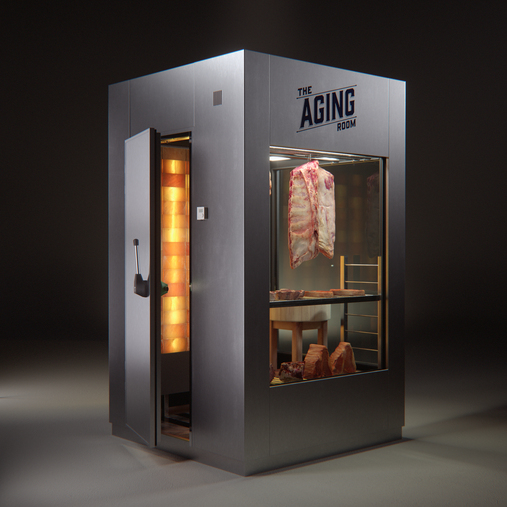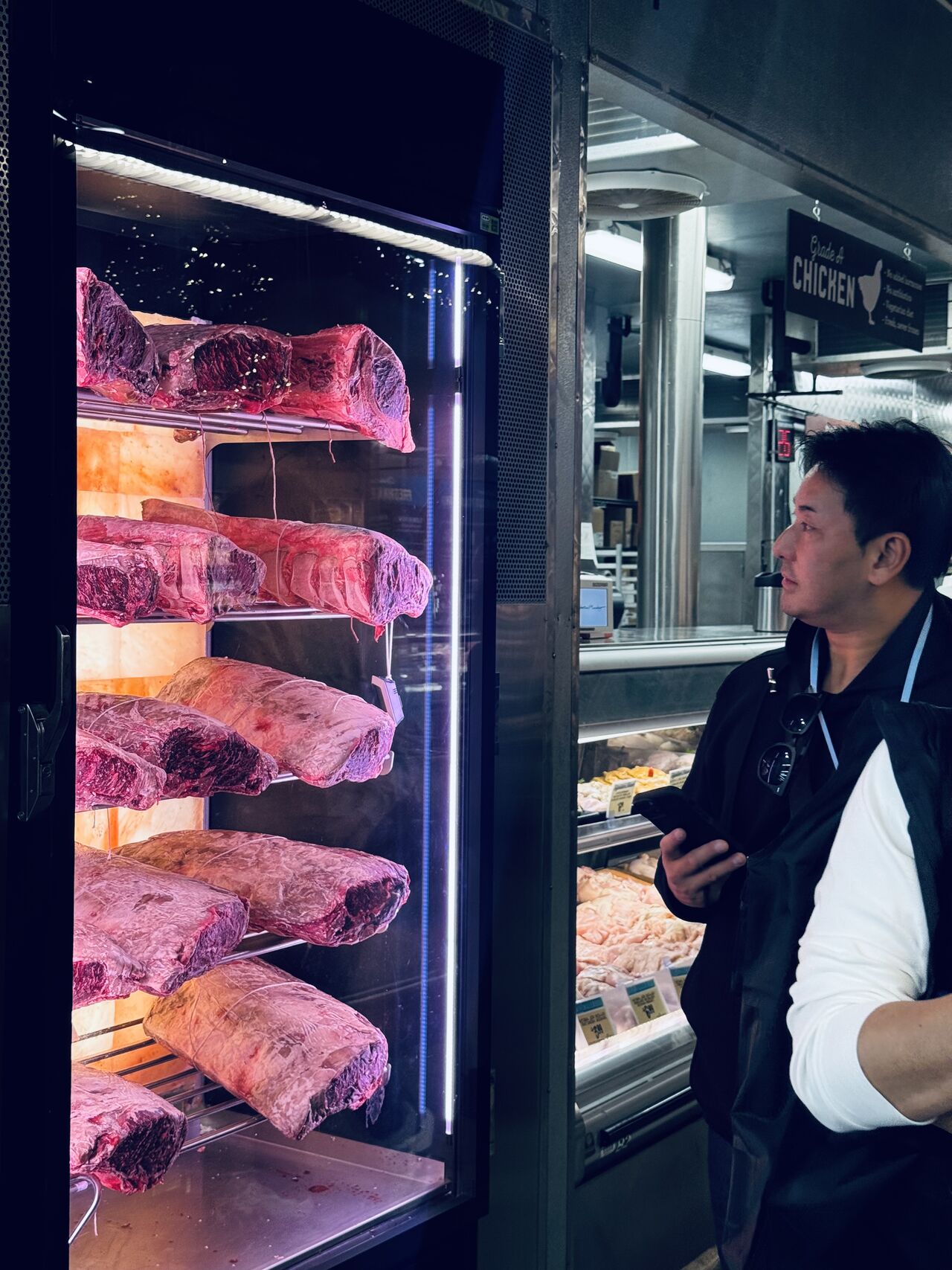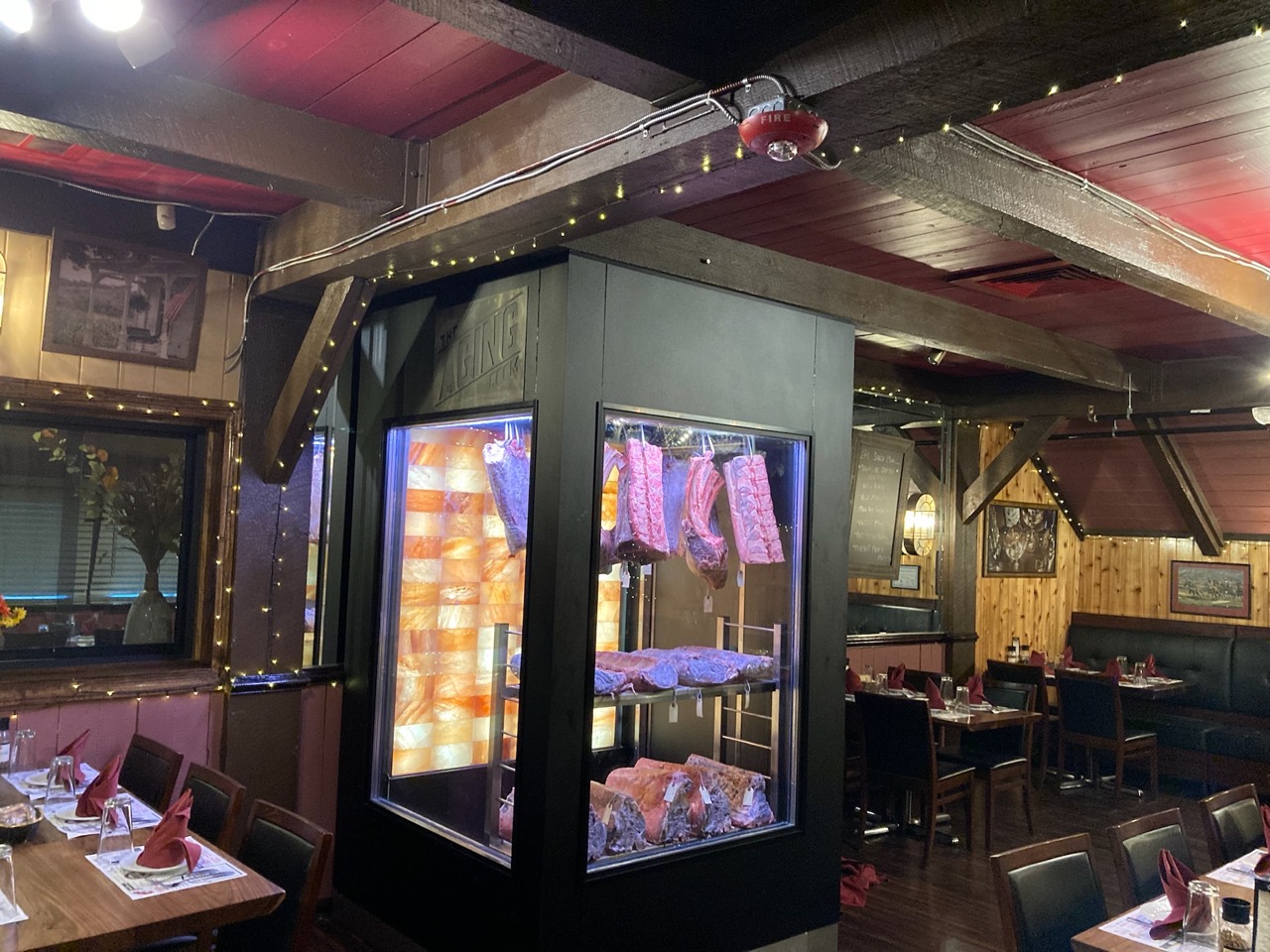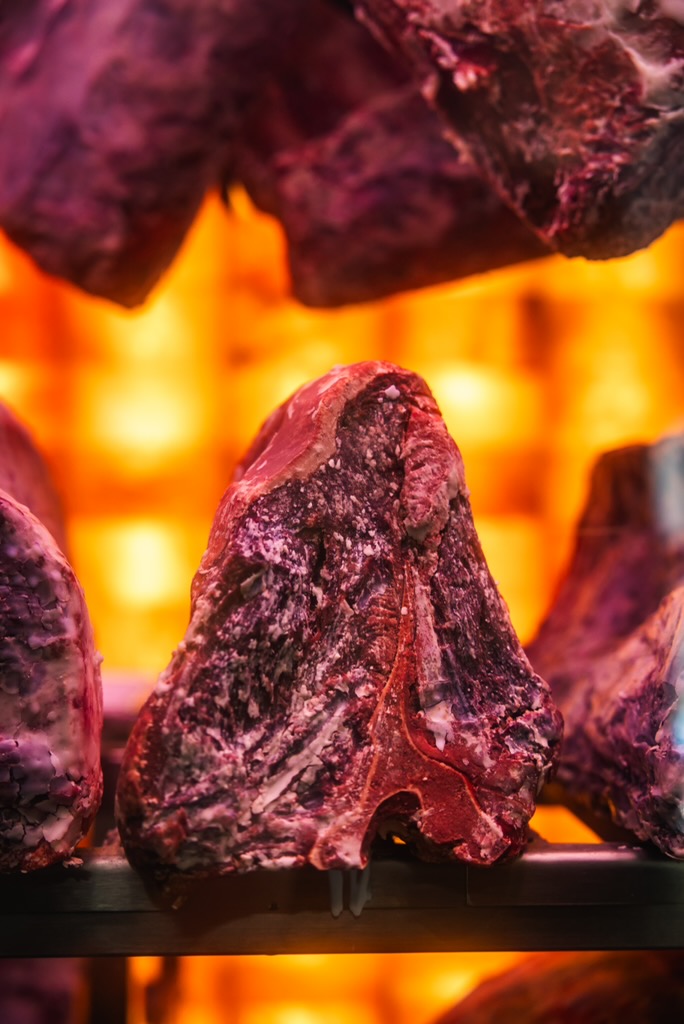
Frequently Asked Questions About Dry Aging Meat
Dry aging meat is a process that has been around for hundreds of years, becoming increasingly popular over the last few decades. Learn more about all things dry aging, from what it is to why you should do it and more.
What is Dry Aging?
Dry aging meat involves exposing a select cut of beef in a controlled, open-air environment to enhance its flavor and tenderness. The meat is placed in a dry-aging beef chamber with specific temperatures and humidity levels. As the moisture is pulled out, the natural enzymes in the beef break down the muscle over time which makes it tender. The balanced and controlled temperature levels on top of the salt in the air keep the dry-aged steak from spoiling.
Which Statement Best Describes Dry Aging?
Dry-aging beef involves drawing out moisture and redistributing it through the beef to create a tender select cut of beef with dense flavor and rich, nutty notes. Using a dry-aging cabinet, you can significantly improve the steak-eating experience. It allows you to control temperature, humidity, air volume, and ventilation levels in order to properly manage the beef.
What Does Dry Aging Mean?
Dry aging is a technique where unwrapped cuts of beef are stored in a dry-aging chamber where all aspects of the environment are strictly regulated like temperature, humidity, air circulation, and bacteria levels. Through the controlled environment, natural enzymes break down the meat without spoiling, making it become naturally more tender. It matures the flavor of the meat, becoming richer and denser.
What Meats Can Be Dry-Aged in The Aging Room?
In The Aging room, meat other than beef can be dry-aged. This includes higher fat-content portions of pork, lamb, and game meat such as deer (hunted responsibly, of course). The ripening period for these meats varies with beef able to ripen the longest. Poultry and fish are recommended to be dry-aged separatly from other meats.
Why Dry Age Beef?
Dry-aging beef can improve it in two ways. First, it enhances the flavor to a distinctive, rich, and dense beefy flavor. Then, it tenderizes the meat and creates a butter-like texture. For a restaurant, dry-aging beef can put a business on the map, setting it apart from its competitors and allowing customers to expand their palettes.
Is Dry Aging Safe?
Dry-aged beef is safe to eat since it’s created with a controlled process. Using a dry-aging chamber, butchers and steakhouses can keep the beef free of harmful bacteria with cold, dry air circulation. Hanging the beef within the chamber, the entire surface of the meat is exposed to dry air that forms a protective crust. The lack of moisture makes it difficult for the beef to spoil.
What is the Purpose of Dry Aging Beef?
Dry-aging beef creates a unique and delicious flavor that can only be achieved through this process. For steak lovers, it is a next-level eating experience as the meat is super tender and softer, making it easier to cut through and digest. At restaurants, having dry-aged beef on the menu attracts steak enthusiasts and beef lovers, setting them apart from the competition.
What is the Benefit of Dry Aging Steak?
Dry-aging meat improves the eating quality of the beef itself. It deepens the flavor, enhancing the tenderness and texture through the natural breakdown of enzymes in a controlled environment. The tenderness also creates a softer piece of beef, which makes it easier to cut through and digest compared to “traditionally” cooked steak.
Can Dry Aging Go Bad?
As long as dry-aged beef is created in a chamber or room specifically designed for the dry-aging process, the beef can stay in as long as a butcher or cook desires. The longer a select cut of beef ages, the stronger the flavor and aroma. Due to the controlled environment, the beef is kept free of harmful bacteria due to the controlled humidity and temperature levels and dry air regularly circulating. The lack of moisture in the room or chamber makes it difficult for any harmful bacteria to spoil any meat.
Can I Dry Age Beef?
Dry-aging typically occurs in a warehouse. Using a dry-aging chamber, restaurants can dry-age beef directly in-house. This allows the chef to express their creativity while also creating an exclusive, “behind-the-scenes” experience for customers to observe how dry-aging works.
How Long Can Dry Aging Last?
Because of the controlled environment, how long you want to dry-age steak is entirely up to what type of experience you want to offer customers. While a typical time frame for dry-aging meat is about 30 days, high-end restaurants may dry-age their meat up to 240 days. The longer you age beef, the stronger the flavor.
Where Did Dry Aging Beef Originate?
Dry-aging beef goes back thousands of years, one of the oldest methods in the world to tenderize the beef and make it more flavorful. Back then, the procedure was called the “hanging” of meat because it was hung up by a hook. During the 1970s, the meat had been dry-aged until vacuum technology was created. Then, wet aging was adopted as it enabled a faster maturing process. In recent years, dry-aging has regained popularity due to the unique, rich flavor and tenderness that can only be achieved through this process.
Is Dry Aging Steak at Home Safe?
In order to produce safe, dry-aged meat, you need to have a dry-aging chamber that can control temperatures, humidity, air circulation, and bacteria levels. Because a standard refrigerator can fluctuate in things like temperature and air circulation, it can be very difficult to safely dry-age at home. Dry-aged steaks can be purchased at local butchers and even from restaurants to be cooked at home.
Is Dry Aging Healthy?
Dry-aging has additional benefits when the natural enzymes act on the meat during the aging process. As it makes the beef more tender, it becomes easier to chew and digest. This is especially beneficial to individuals who have trouble with digestion after eating beef. Like any red meat, it can be healthy to eat in moderation.
How Does Dry Aging Work?
By using a dry-aging chamber, precise electronic temperature control and a good ventilation system helps control the temperature, humidity, air circulation, and bacteria levels to break down the natural enzymes and remove moisture from beef. This causes the beef to have a dense flavor with nutty and rich notes. It also makes the beef more tender, as though you could cut through it with a butter knife.
How Does Dry Aging Affect a Steak’s Flavor?
Moisture loss is one way that dry-aging affects the steak’s flavor. Some of the flavor compounds and other molecules in the steak also undergo a change that will increase some of the flavor components while reducing others. This creates a distinct, dense beef flavor with nutty and rich notes.
How Do You Dry Age Beef?
Dry-aging beef requires a perfect climate. A dry-aging chamber is built to dry-age beef specifically, equipped with a precise electronic temperature control and good ventilation system to ensure proper dry-aging. In the chamber, the beef will be chilled at a certain temperature and humidity levels. To keep the beef fresh and clean, the ventilation should also be precisely controlled.
Where to Buy Dry-Aged Steak?
Dry-aged steak has gained popularity in the last few years. Known for its buttery tenderness and umami flavor, dry-aged steak is favored among steak connoisseurs.
In order to dry age steak properly, the meat needs to be put into a controlled environment like a premium aging chamber. Most of the time, dry-aged steak can be bought at restaurants, butcher shops, and other meat retailers. If you’re looking for a dry-aged steak cooked and prepared for you, many steakhouses offer dry-aged steaks on their menu. A butcher shop may have dry-aged steak that you can cook yourself.
How Does Dry Aging Make Beef More Tender?
When dry-aged properly in a premium aging chamber, the controlled humidity, temperature, and ventilation levels cause the natural enzymes in the beef to break down. This process makes the meat more tender, like cutting through butter.
What Does Dry Aging Do?
The dry aging process slowly evaporates the moisture in the beef, drawing it out as well as redistributing it. It also causes the natural enzymes to break down in the beef. Both of these processes are how the flavor and tenderness are achieved that are staples of dry-aged meat.
What Does Dry Aging Do to Steak?
Dry aging process can significantly improve the tenderness and taste of steak. The taste of the dry-aged steak is what consumers are looking for to enjoy and what sets it apart from traditional steaks. When aged properly, the process creates an umami taste, which is characterized as rich, dense, flavorful, and/or nutty.
How Long to Dry Age Beef?
The time frame for dry aging beef can range depending on the strength of the flavor you’re looking to achieve. The dry aging process can range anywhere from 14 to 240 days or even longer, but most dry aging connoisseurs prefer the range to be between 28 to 45 days.
What is Sea Salt Good For?
Sea Salt is used for cooking and baking, an alternative to traditional Table Salt. It comes from the ocean or saltwater lakes and receives minimal processing. Unlike Table Salt, Sea Salt also contains trace amounts of minerals our bodies need like potassium, calcium, and magnesium.
Why is Himalayan Pink Salt better than Sea Salt?
While Sea Salt preserves traces of the minerals like potassium, calcium, and magnesium, it can also contain microplastics due to the pollution in the ocean. This can lead to various inflammatory diseases. Himalayan Pink Salt comes from ancient seas formed before humans and pollution, meaning zero microplastics. It also has traces of more beneficial minerals than Sea Salt, all 84 required by the body.
Which Salt is Healthiest?
Himalayan Pink Salt is considered the healthiest of salts when compared to Table Salt and Sea Salt. It is rich in 84 essential minerals required by the body, contains zero microplastics, and is hand-mined and ground, making it the most naturally derived of the salts.
Is Pink Himalayan Salt the Same as Sea Salt?
Pink Himalayan Salt and Sea Salt are similar in that they are both naturally derived salts from the earth. Sea Salt comes from the ocean and saltwater lakes, but Pink Himalayan Salt comes from an ancient sea. Many specialists rate Pink Himalayan Salt higher than Sea Salt because it is not exposed to the same pollution that Sea Salt is and contains more trace amounts of essential minerals the body needs.
Which is Better: Real Salt or Himalayan Salt?
Himalayan Salt is ranked better than Real Salt by many specialists. Real Salt or Table Salt contains less beneficial minerals than Himalayan Salt and can contain microplastics. Himalayan Salt can contain traces of 84 essential minerals that your body needs and is naturally derived from an ancient ocean.
Why is it Important to Have a Sufficient Amount of Salt for Dry-Aging?
Salt absorbs moisture quickly, allowing it to work effectively in high humidity. In higher humidity, biochemical processes accelerate, achieving umami flavor more rapidly. And this can be achieved only with a sufficient amount of salt, which should be precisely calculated per specific project.


